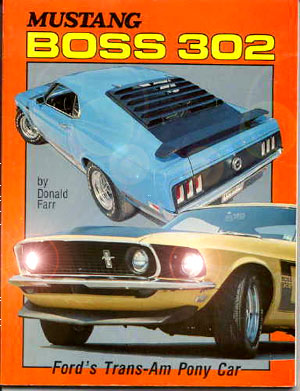
The
most desired and obsolete BOSS 302 book. Recent offers on ebay went up
to 280$.
Donald Farr is the current Editor
of the famous Mustang Monthly Magazine published in the US and
distributed worldwide.
His career started as an amateur photograph
contributing for SAAC
publications and led to
a job from Larry Dobbs as an editor for Mustang Monthly already in 1980.
His most famous book in the Mustang world is the BOSS 302 book pictured
here that is still today a treasure. Even for longtime Mustang and BOSS
enthusiasts.
In our exclusive series of Interviews I am glad that Donald could take
the time to answer my questions... despite his busy schedule and we'd
like to apologize to the BOSS guys for keeping him for a day or two from
working on his new BOSS book:).
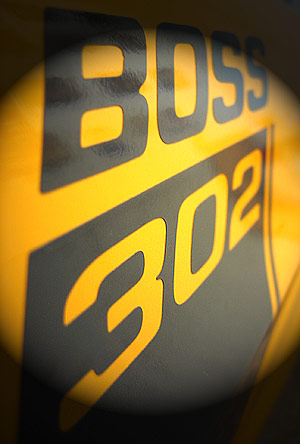
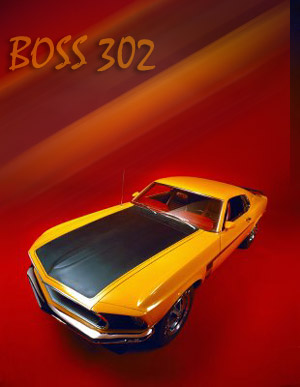
1969 Boss 302
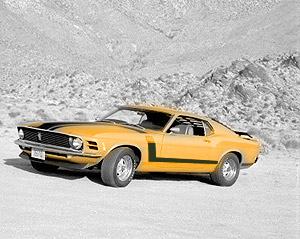
1970 Boss 302
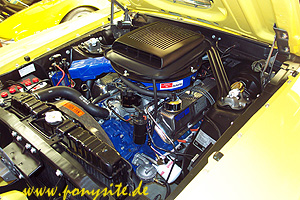
The heart of a Boss 302 is it's high-revving engine
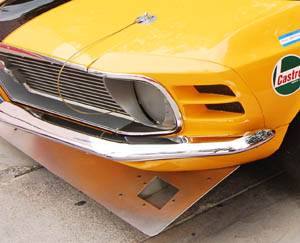
T/A Boss 302 restored
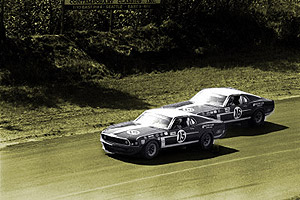
Trans-Am Race Kent 1969
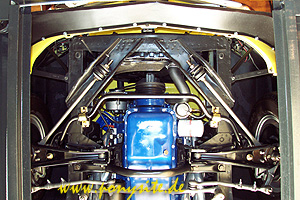
Detailing a Boss 302 from the bottom to top
is just another passion - some like to drive it, some like to make it
perfect.
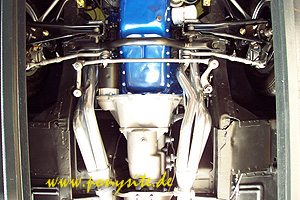
Owner of this yellow Boss 302: Clyde Madsen
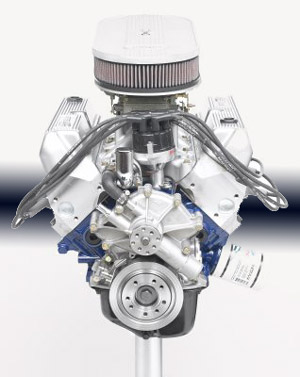
The new Boss crate engine.
|
 |
Exclusive Ponysite interview with
Donald Farr
about the BOSS 302 heritage and future |
"I
knew I had to find a way to own one"
Donald Farr remembers his first
contact with a BOSS 302 and tells us about his sentiments about the BOSS
hype, crate engine and more
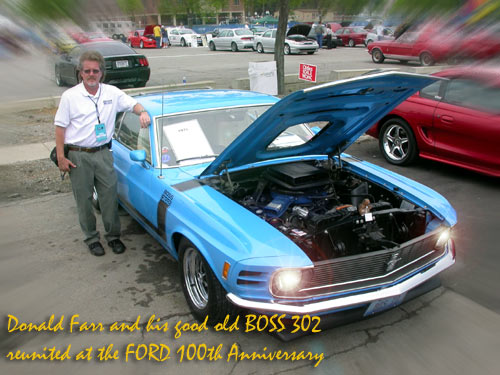
Everybody
knows your Boss 302 book and it is typically in the $150-200 range on
ebay today. Why do you think the Boss guys still value your book so
high?
I
hope itís because itís still a good book with useful information.
Itís the only book that covers the history of the Boss 302 from many
of the people who worked at Ford at the time. But in truth, it probably
sells for so much because itís now out-of-print and hard to find.
When
I wrote the book, I was working at Mustang Monthly, and we published the
book under Mustang Publications, which also published How to Restore
Your Mustang and the Mustang Recognition Guide. We eventually sold the
book division to California Mustang Ė I got royalty checks every month,
very small ones but at least they covered lunch at times. When
California Mustang sold out of the stock we had sent them, they decided
not to reprint because A) they didnít see it as a big seller and B)
the printer had lost the original printing plates.
Can
you tell us something about the research of that book and how you found
the Ford guys for interviews?
Basically,
I started researching the Boss 302 because I owned one and wanted to
know that stuff myself. Guess itís just a journalist thing. Weíre
talking early 1980s, so a lot of the guys were at other jobs or retired.
I tracked down Larry Shinoda Ė he was at White Truck at the time Ė
and he asked me to call him at home. I remember his daughter answered; I
think sheís involved with Boss Shinoda today. Larry ended up doing an interview with me, much of which I used for
the book, and he also helped me track down some of the other people who
were involved, like Matt Donner, who did much of the suspension
development, and Lee Morse, who worked on the engine program. Donner was
retired; his wife answered the phone and called him away from mowing the
grass. Morse eventually became one of the top guys at Ford SVO/Motorsport.
He was the first person I knew with an answering machine. Told me to
call and leave a message, and he would call me right back, which he did.
I think he got so many calls at home from people wanting engine
information that he monitored his calls just so he could have some
family time. He even asked me to leave his name out of the book,
although I did sneak him into the credits up front.
Lew
Spencer, who worked at Shelby-American, helped me with the Trans Am
research. He sent me a lot of information, including a test book, from
the í69 Shelby team. It was there that I spotted a couple of VIN
numbers, so I contacted Lois Eminger, who had the factory invoices.
Through those VINs, she discovered that seven identically equipped
Mustang fastbacks, with consecutive VIN numbers, had been sold to
Administrative Services. Those turned out to the be the original seven
Trans Am cars, three each to Shelby and Bud Moore, and one to Kar Kraft,
which was built to Trans Am specifications for Smokey Yunick in his
black and gold colors. It was exciting to find those VINs.
Do
you think the Boss was really the brainchild of Shinoda only or of a
team? Who else do you know working with Shinoda on the project before or
after he arrived at Ford?
It
was a lot of people working on different things for the same project.
The goal was a production car so Ford could compete in Trans-Am, plus
Ford wanted something to compete in the showroom against the Z/28
Camaro. Shinoda gets a lot of the credit because he came up with the
name and because of the graphics, which were pretty dramatic even for
the late 1960s. Also because Shinoda wasnít shy about boasting about
his talent. The engineering guys were humble; Shinoda was a typical
artist-type.
So
while Shinoda was putting together graphics, the suspension guys were
developing the suspension, in conjunction with the modifications needed
for the F60 tire on the Boss and other Mustangs, and Engine Engineering
guys were doing their thing to create a streetable engine from a race
engine.
If
you had been Larry Shinoda, what else would you have done to the Ď69
and what would you have done different or added on the Boss 302?
Not
much. From hind-sight, the í69 rear spoiler should have been made from
better material so it wouldnít sag, and of course the piston skirts
were a problem.
What
was your first contact with the Boss and how did you feel about it back
then compared to other musclecars of that era?
Itís
funny that I wasnít aware of the Boss 302 until it was out of
production. I grew up in a small town, about 25 miles south of
Spartanburg, SC, so I rarely saw special cars. I was definitely aware of
cars. I had just turned 11 when the Mustang was introduced in 1964, but
the Beatles had more of my attention at the time. Strangely enough, the
two things Iím most interested in Ė music and Mustangs Ė were
introduced to me within the span of two months in 1964 Ė the Beatles
in February and the Mustang in April. At the time, I could play a guitar
but I wasnít old enough to drive a car, so I guess thatís why I
drifted in that direction. Oh, I was still interested in cars. My
grandfather bought a new í66 Mustang GT, and that was cool. I built
model cars and counted Mustangs, Camaros, Corvettes, and Chargers while
going places with my parents.
In
the fall of 1970, my dad got tired of me borrowing the family Mercury
for band practices and dates, so he decided to get me a car. We started
looking a used cars, but he was always of the opinion that ďused cars
are just someone elseís problemĒ so we finally made it to the Ford
dealer to look at Mustangs, which was my first choice anyway. The Ď71s
were already out, but there were two í70 fastbacks still on the lot.
One was a Grabber model, Grabber Green with the í69-like Boss
C-stripes, and the other was pale yellow with the í70-like Boss
stripes, only the stripes started on the door and simply said ď302Ē
at the top. Iíve since learned they were a promotional item to help
dealers dress-up plain fastbacks so they could sell them. I didnít
like the Grabber Green color, so I went for the yellow one. I remember
driving it to school the next day and someone asked me if it was a Boss.
I didnít even know what a Boss was.
A
few months later I was parked at the Sugar ĎNí Spice Drive-In in
Spartanburg, SC. It was one of the popular cruising spots in town. A
real Boss 302, Grabber Blue with Thrush sidepipes, came cruising through.
It was the first one Iíd ever seen, and I was smitten. I knew I had to
find a way to own one, although it would be a few more years before I
would find one for sale.
Although
this question might impose you are a retireeÖ.:) Ė it is not meant
that way - do you have some memory on the average Boss 302 buyer back in
1969 and 1970?
I
didnít know any when the cars were new but I got to know a number of
original owners after trading my Mustang fastback for a Grabber Blue
í70 Boss 302 in 1974. They were a bit older than me, of course, but I
remember they were all car enthusiasts. Theyíd have stacks of car
magazines in the garage.
Did
you ever visit a Trans Am race in Ď69-73?
Growing
up in South Carolina, I was more into NASCAR. I didnít even know about
Trans Am or even much about road-racing, which is strange because Bud
Moore was just up the road in Spartanburg. Iíd heard about Bud, of
course, but only in NASCAR. Nobody in my home town talked about Trans
Am. Most of the races were up north. In 1972 when I was dating my wife,
who lived in Spartanburg, we used to take a short-cut by Bud Moore
Engineering on the way to the movies. Iíd always look for the NASCAR
transporter, not realizing that the pile of cars out pack were actually
wrecked Trans Am Boss 302s.
What
did it mean to be a Ford guy back then? Have you joined a club in the
70ies/80ies?
When
I got my Boss 302 in 1974, it was like being on an island. I didnít
know anyone else with a Boss 302. Then I spotted a letter in Popular Hot
Rodding magazine from Danny Rockett in North Carolina. He was starting a
Boss 302 club and wanted to hear from other Boss 302 owners. I sent him
a letter that day. I eventually met him and two other Boss 302 owners
for a Sunday afternoon drive through the mountains. Through Danny, I
learned about the Shelby American Automobile Club and attended my first
Shelby meet, at Pine Mountain, North Carolina. Finally, I was able to
talk to other people with the same interests as me. I was hooked. I
joined SAAC, of course, and later the Mustang Club of America.
It
was actually a Shelby meet that led to my career. I had taken up
photography as a hobby and was registering for a show in Georgia when
the guy behind the table spotted my Nikkormat 35mm camera and asked if
Iíd shoot some photos for him. Turns out, he submitted my photos,
along with his coverage of the event, to SAAC and they showed up in the
club magazine. So I started shooting more, eventually learning to write
as well. The guy behind the table was Chuck Gutke, who now owns Cobra
Restorers.
Iíve
also got to give credit to Austin Craig, who was then president of SAAC
and the magazineís editor. He encouraged me to contribute more, and
really hooked me when he started running my photos on the cover. At one
point, I suggested he add a Boss 302 column to the magazine. He did,
with me writing it. The experience I gained contributing to SAAC
provided me with the confidence to respond to Larry Dobbsí request for
outside contributors for Mustang Monthly, which led to a job there in
1980.
Do
you think Ford is taking care of his enormous enthusiast potential in a
professional way?
I
assume youíre talking about the lawsuits over the Mustang trademark.
Itís not a good thing. Itís coming from Ford Legal, trying to regain
some control over trademarks. I understand that. But the Mustang
companies out there that are being harassed by cease-and-desist letters
and threats from lawyers arenít hurting Ford and its trademarks.
Theyíre helping Ford. Right now, after losing 12 billion dollars, Ford
needs the enthusiasts more than ever.
Could
this potential eventually save Ford? Or let us be more specific, in what
could they help Ford to become profitable again?
Ford
has more problems than enthusiasts can fix, like competition from
overseas automakers who donít have to deal with unions. Nothing
against unions, mind you, but I think there are going to have to be some
concessions to save Ford and other American automakers. And Ford has
relied on trucks and SUVs for so long. I look at the paper every morning
and I see Ford ads for F150s and Expeditions, while the Toyota and
Nissan dealerships are pushing Camrys and other fuel-efficient vehicles.
Do
you still see the US Mustang museum in the next 5 years or 10 years? Or
are the collectors a reason that it is never going to happen?
Itís
not the collectors. Itís Ford. The museum effort needs money from
Ford, and with a loss of 12 billion dollars last year, it ainít gonna
happen any time soon.
Do
you think Boss cars should end up in museums?
A
few, yes. Most, no. I like seeing low-mileage originals, like the ones
Bob Perkins owns, being preserved. You can look at those cars and it
takes you back to when the cars were new. I like that nostalgic feeling.
For some reason, restored cars never seem to capture that feeling
for me. The stance isnít quite right, or usually they are restored too
well.
I
am a bit concerned about the recent prices at Barrett-Jackson and the
other auctions. That attracts collectors, who will tuck the cars away
never to be seen again, and it also makes Boss owners think twice before
they take their cars out on the highways in the midst of drivers who are
paying more attention to their cell phone conversation. Recently, during
one of our Pony Trails cruises, I ended up following a í69 Boss 429. I
remember thinking that I needed to relish that moment because seeing a
Boss 429 Ė or Boss 302, or Shelby Ė on the road, even during a
Mustang event, may soon be a thing of the past. I hope not, but if
values continue rising, owners will be less likely to expose them to the
dangers of the road.
I
donít think the current spike in values can last, except for perhaps
some of the really special cars, like Ed Meyerís early production Boss
429 that sold for $550,000 at B-J. But you never know. I never thought
Eleanor cars would be so popular with the big-dollar set. As someone
pointed out, last year the Chryslers, particularly Hemi cars, were hot.
This year it was Fords, primarily Boss 429s and Shelbys. Next year it
could be something else.
Back
to the Boss. Why would one desire to prefer a high-revving Boss engine
over a low-torquer street machine in good old America? Is that not a
contradiction to the typical use for the privateers at drag strips and
stop lights?
In
truth, the Boss 351 was a better engine than the 302. By the time it
landed in the í71 Boss 351, the musclecar era was ending. And the
í71 just didnít have the same demeanor as the í69-70s. It was
larger, for one thing. If Ford had dropped the Boss 351 into the í70
instead of the 302, similar to Chevrolet upping the Z/28 to a 350 at
mid-1970, it would have been great car, possibly the best overall
performance Mustang ever.
Donít
get me wrong, the Boss 302 was a great engine. Sure, it was a little
sluggish at low rpms, but the thrill at high rpms more than made up for
it.
Most
of the readers letters about paint stripes, coatings or any other
tidbits of restoration refer to the Boss herd of Mustangs. Do you think
Boss enthusiasts are special or more peculiar Mustang enthusiasts than
others? If yes, why?
Itís
kind of weird, really, because these cars that were modified almost as
soon as they left the dealership are now being restored right down to
the grease-pencil markings. I always thought of that as Shelby territory,
but now it has spread to the Boss 302 faithful. Iíve got no problem
with it. In fact, I can appreciate the research and effort that goes
into a totally concours-correct restoration of a Boss 302. Just seems
weird that original rev limiters and smog equipment, which were the
first things that owners tossed in the trash, are now in such high
demand.
When
Ford comes out with a true factory Boss 302 retrocar, how would you
specify the marketing target of that car? Do you think the car will also
appeal to the 16-year-old of today.
Ford
wonít be targeting teenagers. Theyíll be aiming straight at guys my
age, guys who grew up admiring and wanting a í69 or í70 Boss 302.
The new Boss 302 wonít be cheap, and weíre the ones with disposable
income because the kids are out of the house and the mortgage is paid
off. And unlike myself, many of my fellow Baby-Boomers have done well in
business and are now ready to reap the rewards. So they will splurge for
a car like the Boss 302 or new GT500.
If
you were a designer, what would you do on the new Boss 302?
I
think Steve Saleen and Parnelli Jones pretty much nailed it with the
Saleen/Parnelli Jones edition. That is one beautiful car. Good luck to
Ford on bettering that one.
The
new Boss crate engine meanwhile has approached in many an engine shop.
Do you have the feeling the name Boss should be a sticker in this engine?
I
can see what Ford Racing is trying to accomplish by tying the name of
the new engine to a successful racing engine from the past. I understand
that from a marketing standpoint. But unfortunately itís just going to
muddy the water for the original Boss 302. There are already people out
there, even ones who grew up the sixties, who think every 302 is a Boss.
Tagging the new engine as a Boss is only going to make it worse over
time. Now if it had Cleveland headsÖ
Do
you think it is time for a new Boss book by Donald Farr?
Iím
working on it. Slowly, as I have time, but Iím working on it. So much
information has surfaced since I wrote the book 26 years ago. Iíve
been in touch with some of the people who worked on the development -
some new, some I talked with in 1981. Iíve talked with Bud Moore about
Trans Am. I want to fill in some gaps. Unfortunately, Larry Shinoda is
no longer with us.
The
time is probably right for a second edition, with revisions and new
photos. When Ford comes out with a new Boss Mustang, thereíll be
plenty of marketing hype. We may need a new book to put some focus on
the original Boss 302s.
Thanks
Donald, for taking the time for the unexpected Ponysite interview series.
I wish you that you will have more free time for your new book, so that
we can put it on our birthday or Christmas wishlist within the next 10
month from now.
1st. February 2007 - Wolfgang Kohrn
Update February 2011
We heard through some
of our contacts that Donald is hard working on the finishing of the book
- including a number of chapters like the homologation with help from
Walt Hane (published
on this site already in 2006),
more race chapters and of course including the latest design and
development work of the new Boss 302 launched in 2010/2011. Expect it to
be ready for the Boss Reunion.
Update
May 2011
The title of the new book - out in July 2011 - has been revised upon
Donalds and many Mustang Enthusiasts intervention: 
|












